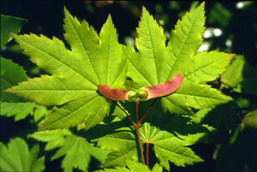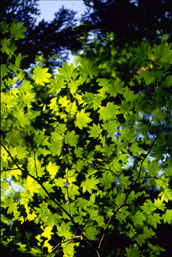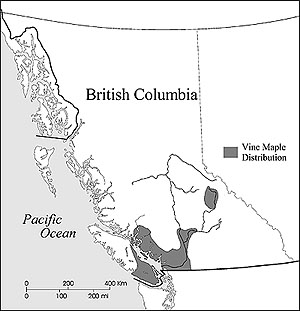| Vine Maple Ecology
The leaves of vine maple are almost circular, with 7-9 pointed radiating lobes; the largest number of lobes seen for any native maple. Reddish-purple and white clusters of flowers appear when the leaves are nearly half grown, and hang from the ends of their branches. Rose coloured seeds, called samaras, appear in summer and ripen in late autumn. In autumn, one cannot miss the vine maple trees as their leaves turn from the initial lime green of summer to an eye catching mustard yellow in the shade, and fire engine red in full sun.
Unlike most hardwood trees of this region which require full sun to grow, vine maple can thrive in both full sun and low light conditions. Due to this versatility of growing in varied light conditions, vine maple can often be found in a range of sites, including recently logged areas or the understory of second-growth and old-growth forests. Different branches on the same trunk of vine maple are of different ages and some can be as old or older than the surrounding trees. Young stems are pale green, allowing them to photosynthesize year round and endure low light conditions beneath the surrounding conifers. Old stems are a dull brown and are often moss covered. Vine maple can reproduce from stems that touch the ground, a characteristic not often found in trees of Coastal British Columbia. New stems may also sprout after a fire from its fire-resistant roots or from a broken stem, allowing this maple to grow and persist over time even after being damaged.
Aboriginals historically used the dense and hard, yet flexible wood of the vine maple for snowshoe frames, drum hoops and a variety of small utensils such as spoons and dishes. Today, vine maple is mainly used as an ornamental tree in gardens. Vine maple is used by many species as habitat. Birds can often be seen hawking for insects found on vine maple leaves and birds commonly roost on its branches. Squirrels, song birds and game birds feed on vine maple seeds, while black-tailed deer and elk like to browse on its leaves and twigs. Mountain beavers will climb several metres to cut off small limbs to feed on, and rabbits often make their homes in patches of vine maple.Despite vine maple's relatively small stature, it can improve soil quality due to its abundant litterfall. Its nutrient-rich leaves decompose rapidly, releasing nurients back to the soil, which can benefit surrounding Douglas-fir. Vine maple litter may also reduce soil acidity and increase soil fertility resulting in taller heights for Douglas-fir.
In Canada, vine maple is native only to British Columbia. Vine maple is found as far north as Knight Inlet on the mainland coast and as far inland as Manning Provincial Park. There are also some isolated occurrences along the Robertson and Salmon Rivers on Vancouver Island, and in wetter parts of the Interior, including Wells Gray Provincial Park. Outside of Canada, vine maple can be found along the coasts of Washington, Oregon and into Northern California. Vine maple is usually found growing in the forest understory amongst plant species such as salal, salmonberry, ocean spray, sword fern, elderberry and huckleberry. Vine maple is commonly seen by hikers, as it forms an archway over trails while growing towards the light. Vine maple grows on a range of sites, from relatively dry to moist , although it grows best in moist soils along banks of streams. |
 Vine
maple (Acer circinatum, Pursh) is a small, irregularly shaped vine-like
tree or shrub commonly found in Pacific Northwest coastal forests. Easily
identifiable by its crooked trunk, arching limbs and fine, star-like foliage,
vine maple can reach heights of up to 10 m and stretch laterally 10 m.
Vine
maple (Acer circinatum, Pursh) is a small, irregularly shaped vine-like
tree or shrub commonly found in Pacific Northwest coastal forests. Easily
identifiable by its crooked trunk, arching limbs and fine, star-like foliage,
vine maple can reach heights of up to 10 m and stretch laterally 10 m.


